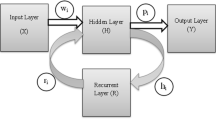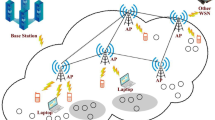Abstract
A Mobile Ad hoc Network (MANET) is a network composed of numerous autonomous mobile nodes. In recent times, the opportunistic network, a type of MANET is gaining a lot of significance among the researchers, as it is capable of communicating with the sink node through an efficient selection of relay nodes. In the opportunistic networks, the node does not seek any knowledge about the network topology as it selects the efficacious relay node for transmission of packets. However, MANET requires nodal information about network topology. In the opportunistic network, the data stockpiled in the packets are transmitted from a source node to a sink node by utilizing relay node opportunistically for every hop. However, this type of communication leads to delayed data delivery with increased hops as a consequence of the unsystematic selection of relay nodes. To overcome these constraints, this article focuses on the selection of optimal relay nodes for attaining faster data delivery, by unveiling the location and by predicting the mobility pattern of the neighbor nodes. Hence, this research paper proposes Particle Swarm Optimization algorithm for the selection of optimal relay nodes by locating the neighbor nodes within an established Inter-Communication Range employing Cartesian based localization technique and by analyzing their mobility pattern using recurrent neural network-long short-term memory prediction model. The results of the proposed methodology are compared with four other existing methods, namely, MaxProp, Spray and Wait, and Epidemic. The comparative results infer that the proposed method is efficient in terms of performance, reduced hops, reduced delay with enhanced packet delivery ratio, and improved overhead ratio.












Similar content being viewed by others
References
Delkesh, T., & Jamali, M. A. J. (2019). EAODV: Detection and removal of multiple black hole attacks through sending forged packets in MANETs. Journal of Ambient Intelligence and Humanized Computing, 10(5), 1897–1914.
Pelusi, L., Passarella, A., & Conti, M. (2006). Opportunistic networking: Data forwarding in disconnected mobile ad hoc networks. IEEE Communications Magazine, 44(11), 134–141.
Huang, C. M., Lan, K. C., & Tsai, C. Z. (2008). A survey of opportunistic networks. In 22nd International conference on advanced information networking and applications-workshops (aina workshops 2008) (pp. 1672–1677). IEEE.
Kuriakose, J., Joshi, S., & George, V. I. (2014). Localization in wireless sensor networks: a survey. In International conference on information communication and embedded system (ICICE2014).
Hu, L., & Evans, D. (2004). Localization for mobile sensor networks. In Proceedings of the 10th annual international conference on Mobile computing and networking (pp. 45–57). ACM.
Venkatesan Theerthagiri, P., & Menakadevi, T. (2019). FMPM FMPM: futuristic mobility prediction model for mobile adhoc networks using auto-regressive integrated moving average. Acta Graphica, 29(2), 7–17.
Ghouti, L. (2016). Mobility prediction in mobile ad hoc networks using neural learning machines. Simulation Modelling Practice and Theory, 66, 104–121.
Yang, H., Li, Z., & Liu, Z. (2019). A method of routing optimization using CHNN in MANET. Journal of Ambient Intelligence and Humanized Computing, 10(5), 1759–1768.
Chirdchoo, N., Soh, W. S., & Chua, K. C. (2009). Sector-based routing with destination location prediction for underwater mobile networks. In 2009 International Conference on Advanced Information Networking and Applications Workshops (pp. 1148–1153). IEEE.
Shin, D., Hwang, D., & Kim, D. (2012). DFR: an efficient directional flooding-based routing protocol in underwater sensor networks. Wireless Communications and Mobile Computing, 12(17), 1517–1527.
Uchiyama, A., Fujii, S., Maeda, K., Umedu, T., Yamaguchi, H., & Higashino, T. (2012). UPL: Opportunistic localization in urban districts. IEEE Transactions on Mobile Computing, 12(5), 1009–1022.
Misra, S., Ojha, T., & Mondal, A. (2014). Game-theoretic topology controlfor opportunistic localization in sparse underwater sensor networks. IEEE Transactions on Mobile Computing, 14(5), 990–1003.
Zaidi, S., El Assaf, A., Affes, S., & Kandil, N. (2016). Accurate range-free localization in multi-hop wireless sensor networks. IEEE Transactions on Communications, 64(9), 3886–3900.
Hadir, A., Zine, D., Bakhouy, E. K., & El, O. (2017). Performance evaluation of DV-hop localization algorithm for geographical routing in wireless sensor networks. Procedia Computer Science, 113, 261–266. https://doi.org/10.1016/j.procs.2017.08.366.
Rozner, E., Seshadri, J., Mehta, Y., & Qiu, L. (2009). SOAR: Simple opportunistic adaptive routing protocol for wireless mesh networks. IEEE Transactions on Mobile Computing, 8(12), 1622–1635.
Ramya, L. P., & Selvan, (2015). Mobility prediction and forwarding routing in delay tolerant networks. Middle-East Journal of Scientific Research, 23, 297–304.
Kafaie, S., Chen, Y., Dobre, O. A., & Ahmed, M. H. (2018). Joint inter-flow network coding and opportunistic routing in multi-hop wireless mesh networks: A comprehensive survey. IEEE Communications Surveys & Tutorials, 20(2), 1014–1035.
Bansal, S., Sivia, J. S., & Bindra, H. S. (2019). Design, implementation and analysis of routing based attack model for delay tolerant networks for prophet routing protocol. International Journal of Sensor Networks, 31(4), 238–252.
Hui, P., Crowcroft, J., & Yoneki, E. (2010). Bubble Rap: Social-based forwarding in delay-tolerant networks. IEEE Transactions on Mobile Computing, 10(11), 1576–1589.
Kaaniche, H., & Kamoun, F. (2010). Mobility prediction in wireless ad hoc networks using neural networks. arXiv preprint arXiv:1004.4610.
Chen, Q., Kanhere, S. S., & Hassan, M. (2012). Adaptive position update for geographic routing in mobile ad hoc networks. IEEE Transactions on Mobile Computing, 12(3), 489–501.
Seema, R., & Ajay, D. (2014). Survey on mobility prediction schemes in MANET with clustering techniques. Journal of Advanced Research in Computer Engineering & Technology, 3(6), 2131–2134.
Suraj, R., Tapaswi, S., Yousef, S., Pattanaik, K. K., & Cole, M. (2015). Mobility prediction in mobile adhoc networks using a lightweight genetic algorithm. Wireless Networks, 22, 1–10.
Leng, J., & Jiang, P. (2016). A deep learning approach for relationship extraction from interaction context in social manufacturing paradigm. Knowledge-Based Systems, 100, 188–199.
Leng, J., Chen, Q., Mao, N., & Jiang, P. (2018). Combining granular computing technique with deep learning for service planning under social manufacturing contexts. Knowledge-Based Systems, 143, 295–306.
Xue, J., Li, J., Cao, Y., & Fang, J. (2009). Advanced PROPHET routing in delay tolerant network. In International Conference on Communication Software and Networks (pp. 411–413). IEEE.
Nasab, A. S., Derhami, V., Khanli, L. M., & Bidoki, A. M. Z. (2012). Energy-aware multicast routing in manet based on particle swarm optimization. Procedia Technology, 1, 434–438.
Yang, X. S., & He, X. (2013). Firefly algorithm: Recent advances and applications. arXiv preprint arXiv:1308.3898.
Gandomi, A. H., Yang, X. S., & Alavi, A. H. (2013). Cuckoo search algorithm: A metaheuristic approach to solve structural optimization problems. Engineering with Computers, 29(1), 17–35.
Gaur, Priti. (2013). An efficient routing implementation using genetic algorithm. Journal of Computer Science and Information Technology, 2(7), 250–257.
Biradar, A., & Thool, R. C. (2014). Reliable genetic algorithm based intelligent routing for MANET. In 2014 World Congress on Computer Applications and Information Systems, WCCAIS 2014. Institute of Electrical and Electronics Engineers Inc.
He, X. S., Ding, W. J., & Yang, X. S. (2014). Bat algorithm based on simulated annealing and Gaussian perturbations. Neural Computing and Applications, 25(2), 459–468.
Pardeep, K., & Kaur, Surinder. (2014). Use of Hybrid GA and PSO for Routing Optimization in MANET. Journal of Advanced Research in Computer Science and Software Engineering, 4(7), 52–60.
Robinson, Y. H., & Rajaram, M. (2015). Energy-aware multipath routing scheme based on particle swarm optimization in mobile ad hoc networks. The Scientific World Journal, 2015, 1.
Rajan, C., & Shanthi, N. (2015). Genetic based optimization for multicast routing algorithm for MANET. Indian Academy of Sciences, 40(8), 2341–2352.
Koushik, C. P., & Vetrivelan, P. (2019). Gradient-based localization and relay nodes selection in delay tolerant mobile opportunistic networks for emergency rescue. In Wireless Communication Networks and the Internet of Things (pp. 21–32). Singapore: Springer.
Papaj, J., & Doboš, Ľ. (2014). Trust based algorithm for candidate node selection in hybrid MANET-DTN. Advances in Electrical and Electronic Engineering, 12(4), 271–278.
Goldbarg, E. F., Goldbarg, M. C., & de Souza, G. R. (2008). Particle swarm optimization algorithm for the traveling salesman problem. Traveling Salesman Problem, 1, 75–96.
Rani, A., Rani, S., & Bindra, H. S. (2014). Performance Evaluation of MaxProp Routing Protocol with DL, FIFO, DLA and MOFO Buffer Management Techniques in DTN under Variable Message Buffer Size. IJERT, ISSN, 2278-0181.
Pan, D., Lin, M., Chen, L., & Sun, J. (2012). An improved spray and wait with probability choice routing for opportunistic networks. Journal of networks, 7(9), 1486.
Zhang, F., Wang, X., Zhang, L., Li, P., Wang, L., & Yu, W. (2017). Dynamic adjustment strategy of n-epidemic routing protocol for opportunistic networks: A learning automata approach. TIIS, 11(4), 2020–2037.
Author information
Authors and Affiliations
Corresponding author
Additional information
Publisher's Note
Springer Nature remains neutral with regard to jurisdictional claims in published maps and institutional affiliations.
Rights and permissions
About this article
Cite this article
Koushik, C.P., Vetrivelan, P. Heuristic Relay-Node Selection in Opportunistic Network Using RNN-LSTM Based Mobility Prediction. Wireless Pers Commun 114, 2363–2388 (2020). https://doi.org/10.1007/s11277-020-07480-2
Published:
Issue Date:
DOI: https://doi.org/10.1007/s11277-020-07480-2




